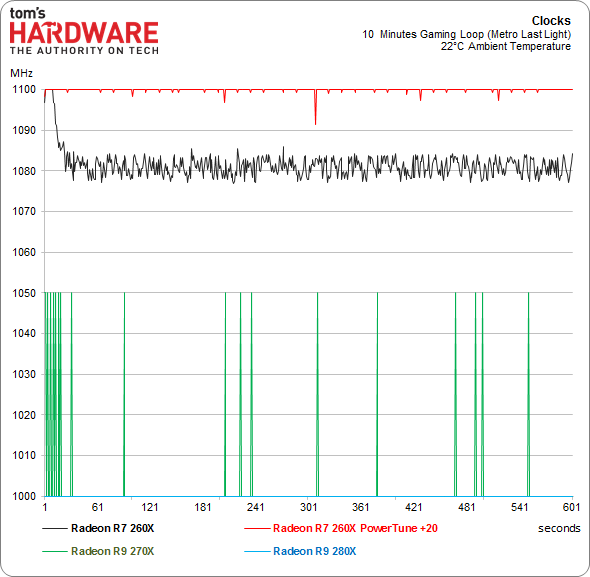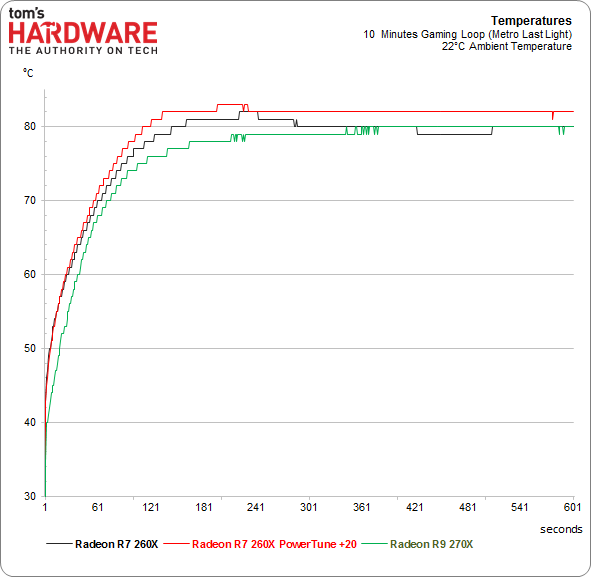AMD Radeon R9 280X, R9 270X, And R7 260X: Old GPUs, New Names
AMD is introducing a handful of new model names today, based on existing GPUs. Do the company's price adjustments make this introduction newsworthy, or will the excitement need to wait for its upcoming Radeon R9 290 and 290X, based on fresh silicon?
Clock Rate And Temperature
The same challenges that faced us in trying to create a reference R9 280X for our power consumption testing also affect our frequency monitoring and thermal readings. Again, our U.S. and German offices received different partner boards with a variety of configurations. AMD, for some reason, pinned an embargo on those third-party products that expires later, so we’re setting aside measurements of the 280X for a round-up instead.
What we want to illustrate, though, are the effectively-achievable clock rates under load:
While the R9 280X that we adjusted to behave like a reference model can sustain the higher frequencies in real-world gaming conditions, the R7 260X and the R9 270X behave differently. We got the R7 260X to hit an almost-constant 1100 MHz by using the +20 setting in PowerTune, but saw little difference from the R9 270X. Tuning the card’s settings allows us to hit its peak clock rate more often, but that’s still not enough to call its ceiling a usable increase. This is why we’re using the R7 260X with its two PowerTune setups for our thermal measurements.
Temperatures Under Realistic Load
We took our thermal readings in a closed-up Corsair Obsidian 900D with its case fans spinning slowly and an ambient temperature of 22 degrees Celsius.
The R9 270X’s temperature rises and then levels off at around 80 degrees. In contrast, the R7 260X hits a peak value (with and without our PowerTune adjustment) and then backs off before stabilizing. These differences are the result of an evolved fan controller, which we’ll look at on the next page. Both reference cards seem to be designed for a maximum temperature of 80 degrees Celsius, though. By raising the PowerTune value, we’re able to push that boundary up.
Get Tom's Hardware's best news and in-depth reviews, straight to your inbox.
-
CaptainTom Wow what's with the AMD hate? As it stands they are doing the same thing Nvidia did except without the outrageous prices. The GTX 770 wasn't a great deal when the 7970 was $50 cheaper. Have fun trying to run BF3 with 2GB of VRAM...Reply -
slomo4sho Nothing revolutionary but better prices I suppose.Reply
The MSI R9 280X Gaming at $299 appears to outperform the GTX 770 at 1600P and is within margin of error at 1080P according to Techpowerup. Not a bad value at $100 less and still overclocks well:
http://www.techpowerup.com/reviews/MSI/R9_280X_Gaming/26.html -
jimmysmitty So long story short, if you have a HD7970GHz then these do nothing for you.Reply
Best to hold out till the reviews on the R9-290X I guess. But considering the specs I hope for at least 20% performance increases over a 7970. -
Shankovich What happened to Chris? I didn't see this kind of hate with all of the 700 series rebrands. Also, to the Canadians here, grab the $270 7970 GHz edition cards while you still can.Reply -
BigMack70 I don't like this new strategy AMD and Nvidia are taking of rebranding an old series at improved price points and then releasing only one new chip at a stupidly expensive price point.Reply
Are the days of (nearly) annual simultaneous full line GPU launches from $100-500 with a dual GPU chip to follow at $750-1000 really over? -
cangelini Hate? The R9 280X won an *award*. I think Tahiti at $300 is pretty much brilliant.Reply
I wrote one of the least flattering GTX 780 stories out there. I only identified a couple of situations where a Titan made any sense at all. And although the 760 *did* change the balance at $250, that card still didn't get an award. I liked the 770 for the simple fact that it delivered better-than-680 performance for close to $100 less.
The rest of AMD's new line-up is a lot like what exists already. Again, the 7870 is a better value than 270X. So what are you getting worked up over? The fact that I'm pointing out these aren't new GPUs? They're not. ;) -
Shankovich Ok Chris, I agree with you, sorry for the over reaction. But I really don't like how nVidia made price increases for some of the rebrands. Looking forward to your 290 and 290X reviews :DReply -
ingtar33 i'll take a 7950 at $129 thank you very much (or two). There is a major retailer selling them for that this week. Best buy all year. two 7950s for the price of one r9-280x? yeah... i'll do that all day every day.Reply -
tomfreak Radeon 7790 has true Audio = but not enabled boooooo = as a 7790 owner I somewhat disappointed :( . Anyone have any idea if we can crossfire 1GB 7790 and 2GB 260x?Reply -
net_nakul By the time a R9 380X comes out, the GCN Tahiti XT achitecture may be 4 years old (assuming end of 2015). AMD better come up with an awesome new architecture by then, considering the R&D time they have.Reply
That goes to you too Mr. NVIDIA


